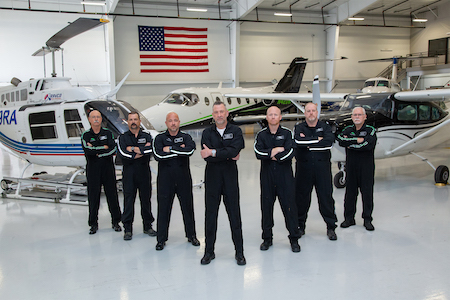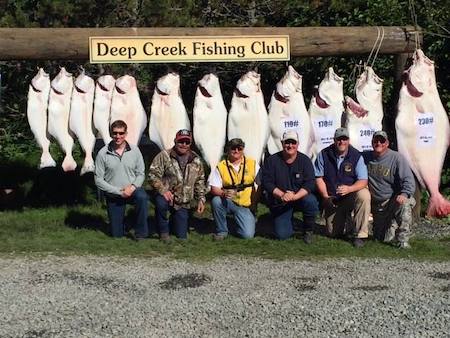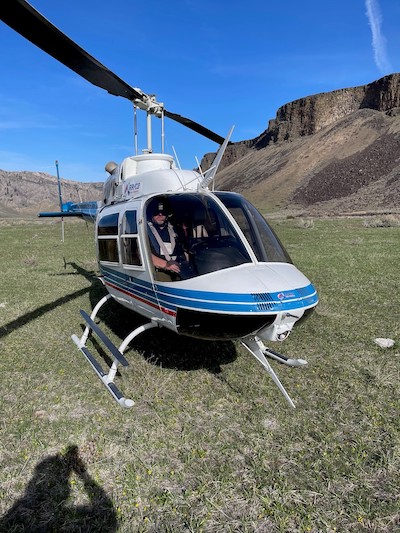|
Sep
12
2022
|
|
Posted 3 years 129 days ago ago by Admin
|
|

“I never really thought I’d have the title “Vice President” in front of my name. Coming out of the Army as basically an A&P mechanic, I never really thought my career would reach this level; it’s a pretty daunting responsibility to be honest,” says Vice President Kip McDermott of night vision leader Aviation Specialties Unlimited (ASU) in Boise, Idaho. His current responsibilities seem daunting for sure: working with government regulators all over the world, writing test plans, certification plans, and wrangling designated engineering representatives (DERs) up for engineering reports, overseeing a Part 145 repair station along with ASU’s Part 135 and Part 141 flight operations groups, as well as being responsible for supplemental type certificate (STC) certification and ASU’s highly regarded night vision goggle (NVG) lab would “daunt” any executive, but McDermott is confident he can handle his lengthy list. If he loses his grip, he says there’s help, “The saving grace of it all is that I’ve got good guys I’m working with; I don’t have to micromanage them (I’ve never been a micromanager and will never be.) They make my job easier; if I drop something, they pick it up.”
From mechanic to VP is a rare career path, but that ASU company culture of collaboration was a boost that allowed the once Army mechanic to climb to vice president of a corporation known for bringing military night vision technology to civilian aviation. “We have great folks here willing to mentor. Everyone helps everybody along here,” he says. “No one here will let another guy or gal fail. That’s really what allowed me to spread out and strengthen my weaker areas.”

Mentoring
Those weaker areas were strengthened by mentorship, including the hands-on involvement of now-retired ASU founder Mike Atwood. “There wasn’t a day that I didn’t have some interaction with him. A lot of owners and executives are hardly seen; they’re in some office away. That wasn’t Mike; he was right beside you,” McDermott says. Such mentorship smoothed McDermott’s rougher edges. “A lot of us mechanics are weaker on some of the business-side areas like human resource management. We’re generally a little harder than we need to be in managing personnel. Good mentorship and training helps temper those tendencies,” McDermott also shored up another shortcoming. He says, “All of us who have been directors of maintenance (DOM) don’t want to pay attention to the money side of the business. We’re focused on the job at hand and solving problems in the shop, but if you don’t pay attention to the money side of the house, then you won’t have any job in a few years. I learned that you have to be accountable and answer for the hours and costs of maintenance and parts.” Toward this end, ASU changed its business philosophy a few years ago to bring younger colleagues (The company calls employees colleagues.) into the budgeting process. “We have repair station managers managing budgets and revenue flow. Their getting to see the business side of the house helps them to better understand what needs to happen. People throughout the company get to be part of these management decisions and they’re not just worker bees working day to day to day. They’re exposed to the business side and get to understand it. Just as I was mentored, we mentor them through this process. It goes from the top all the way to the bottom. As a product of that process, I think it’s the reason ASU’s still here banging around in this industry after 25 years when a lot of others haven’t made it.”
Longevity
That multi-decade stability is another key to both McDermott’s and ASU’s success. After working in Germany for a total of six years as a young A&P licensed mechanic for both the Army (B co. 70th Transportation Battalion; Mannheim, Germany, Coleman Army Airfield) and also for U.S. Department of Defense contractor, Dynacorp (also in Mannheim), McDermott returned to his native Idaho in 1996. (He says he “took a big pay cut” to return.) After working for a few Boise-based aviation companies as a wrench-turner and maintenance manager, McDermott started his ASU career in March 2002 and has advanced with them ever since, reaching the executive ranks as vice president of engineering in 2016 and on June 1 of this year his promotion to vice president of aviation operations was announced. Mcdermott’s lengthy tenure is not unusual for ASU. He says, “Most of our staff are long-term colleagues. We don’t hire people for just a year, but usually hire them for as long as they want to work with us.”
Marriage
Other than his career at ASU, another multi-decade milestone is his marriage to his high school classmate, Stacey, who is COO of the Idaho Hospital Association. He says, “I’m hoping I’ve got another 25 years, or more, of marriage with Stacey.” With their children grown and out of the house, they enjoy traveling together. McDermott especially enjoys outdoor sports, such as whitewater rafting and fishing.

Attitude
As most executives we’ve profiled indicate, McDermott says if you want to get hired, it’s best to bring your A-game—A as in an awesome attitude. He says, “We hire a lot based on a person’s personality because employees can go on the road with each other for weeks at a time. We are a family. That’s not just a hokey term. For example, I’ve got two guys who spent the last three weeks in Turkey. They left Turkey and they’re now spending another three weeks in Austria doing installs. Getting along with your colleagues is not just a nice thing; it’s essential to what we do. When new hires did not work out, it’s usually because they didn’t mesh well with the team. Our staff will get them up to speed technically, but to do that we have to hire good, willing folks. Give me a basically competent person with a good attitude that’s willing to learn over an extremely competent jerk.” While international travel and foreign work for weeks and months at a time seems tough, McDermott does not overlook dedicated colleagues. He says, “I’ll try to make sure they’re rewarded either monetarily or with better quality of life stuff, such as a better work-life balance. If guys and gals are honest and they’ve got a great work ethic, they’re golden.”
Leadership
Those types of colleagues are not the only thing that McDermott considers golden. He also has his own golden-rule management philosophy that he models: “Some advice that stuck with me is don’t ask your guys to do something you’re not willing to do yourself.” Therefore, McDermott occasionally goes out on the shop floor with his tools in hand. “I’ll go do an install right next to our newest installer within the Part 145 repair station. My leadership style begins with hiring good people and then setting a good example for them.” Another facet of his leadership is listening. McDermott also offers this gold nugget mined from experience: “I’ve also learned to let my team run. Just because someone comes up with a good idea I didn’t think of doesn’t mean we don’t try it. It can work out better than our present way of doing things. In aviation we tend to be Type-A confident people. That doesn’t mean we have all the answers. You can be confident, but don’t be arrogant. I think a lot of times confidence and arrogance get confused.”

Regulations
One area with which McDermott has no confusion is the need for he and ASU to clearly communicate with government regulatory agencies, both foreign and domestic, as over 50% of ASU’s business now is international. “Regulatory bodies are always one of our largest challenges, but they can also present opportunities. They sometimes request that we do work for them. Most regulators are technically savvy and willing to learn, so we have the opportunity to educate them, as well as to learn from them. Everybody usually comes from a project learning something they didn’t know going in,” he says. An example he gives of successfully working with regulators is how ASU and others in the integrated night vision imaging system (NVIS) sector worked with the FAA to write rules to integrate that new technology into civilian aircraft shortly after the beginning of this century. “It took years to sort out and realize that each aircraft should be handled in its own regard. In those years we (ASU) worked side by side with the FAA to build rules and processes for NVIS because there were no guidelines. We were so early into the market that we didn’t know when changing a light (in the cockpit to accommodate NVGs) was a major or minor modification. It’s pretty good now, 20 years later, because the rules exist for many situations and are fairly written.” He mentions that part of that cooperative process was NightCon, an annual event, now dormant, during that time of burgeoning night vision that brought together participants in the INVIS industry with regulators to dialogue. (Note: Rotorcraft Pro co-sponsored those conventions) “To be honest, I wish that forum was still happening and maybe we can get back to it in the future,” McDermott says.
Of course, dealing with regulatory agencies around the world doesn’t always go as smoothly. McDermott says, “We have to be flexible and know how to pivot when circumstances warrant. That can be tough, but we keep killing it and making it happen, so we must be doing something right, even on the tough days.”
Final Toast
Even when times are tough, McDermott sees more right about the rotorcraft industry than wrong. (He’s backing up his optimism by taking his checkride exam in August for his rotorcraft private pilot license with plans to earn his DER certification for future helicopter projects.) “Helicopters are a worldwide business, but it’s still very small and you get to know people over a burger and a beer. In this industry, everyone seems to know how to separate business from their social life,” he says. “You can compete hard against your competitors, but at the end of the day, you can sit down with them over a beer and enjoy their company and respect what they do and they can do likewise.”
The wrench-turner who turned vice president over a long, consistent career with a long-time, consistent company ends with this beer toast, “We’ve seen all the companies come and go, but if you’re still standing at the end of the day, you’re doing a good job too.”
Cheers.
READ MORE ROTOR PRO: https://justhelicopters.com/Magazine
WATCH ROTOR PRO YOUTUBE CHANNEL: https://buff.ly/3Md0T3y
You can also find us on
Instagram - https://www.instagram.com/rotorpro1
Facebook - https://www.facebook.com/rotorpro1
Twitter - https://twitter.com/justhelicopters
LinkedIn - https://www.linkedin.com/company/rotorpro1